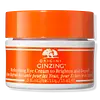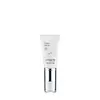What's inside
What's inside
 Key Ingredients
Key Ingredients

 Benefits
Benefits

 Concerns
Concerns

 Ingredients Side-by-side
Ingredients Side-by-side

Water
Skin ConditioningButylene Glycol
HumectantPEG-100 Stearate
Dimethicone
EmollientSilica
AbrasiveCetyl Ricinoleate
EmollientOlea Europaea Fruit Oil
MaskingGlycerin
HumectantPanax Ginseng Root Extract
EmollientCoffea Arabica Seed Oil
MaskingCaffeine
Skin ConditioningCitrus Aurantium Dulcis Peel Extract
Emulsion StabilisingAminopropyl Ascorbyl Phosphate
AntioxidantCaprylic/Capric Triglyceride
MaskingHypnea Musciformis Extract
Skin ProtectingGelidiella Acerosa Extract
Skin ProtectingSigesbeckia Orientalis Extract
Skin ConditioningAscophyllum Nodosum Extract
Skin ConditioningChrysanthellum Indicum Extract
Skin ConditioningAsparagopsis Armata Extract
Skin ProtectingCucumis Sativus Fruit Extract
EmollientPyrus Malus Fruit Extract
Skin ConditioningScutellaria Baicalensis Root Extract
AstringentSaccharum Officinarum Extract
MoisturisingButyrospermum Parkii Butter
Skin ConditioningSimmondsia Chinensis Seed Oil
EmollientSodium Hyaluronate
HumectantNiacinamide
SmoothingLinoleic Acid
CleansingPhytosphingosine
Skin ConditioningTocopheryl Acetate
AntioxidantMethyl Trimethicone
Skin ConditioningTrehalose
HumectantTribehenin
EmollientInulin
Skin ConditioningSorbitol
HumectantEthylhexylglycerin
Skin ConditioningCaprylyl Glycol
EmollientTocopherol
AntioxidantMyristyl Alcohol
EmollientHydrogenated Lecithin
EmulsifyingJojoba Wax PEG-120 Esters
Carbomer
Emulsion StabilisingBehenyl Alcohol
EmollientSodium Hydroxide
BufferingBHT
AntioxidantHydroxyacetophenone
AntioxidantSodium Metabisulfite
AntioxidantSodium Sulfite
PreservativeDisodium EDTA
Phenoxyethanol
PreservativeChlorphenesin
AntimicrobialSorbic Acid
PreservativePotassium Sorbate
PreservativeMica
Cosmetic ColorantCI 77891
Cosmetic ColorantCI 77491
Cosmetic ColorantCI 77492
Cosmetic ColorantCI 77163
Cosmetic ColorantWater, Butylene Glycol, PEG-100 Stearate, Dimethicone, Silica, Cetyl Ricinoleate, Olea Europaea Fruit Oil, Glycerin, Panax Ginseng Root Extract, Coffea Arabica Seed Oil, Caffeine, Citrus Aurantium Dulcis Peel Extract, Aminopropyl Ascorbyl Phosphate, Caprylic/Capric Triglyceride, Hypnea Musciformis Extract, Gelidiella Acerosa Extract, Sigesbeckia Orientalis Extract, Ascophyllum Nodosum Extract, Chrysanthellum Indicum Extract, Asparagopsis Armata Extract, Cucumis Sativus Fruit Extract, Pyrus Malus Fruit Extract, Scutellaria Baicalensis Root Extract, Saccharum Officinarum Extract, Butyrospermum Parkii Butter, Simmondsia Chinensis Seed Oil, Sodium Hyaluronate, Niacinamide, Linoleic Acid, Phytosphingosine, Tocopheryl Acetate, Methyl Trimethicone, Trehalose, Tribehenin, Inulin, Sorbitol, Ethylhexylglycerin, Caprylyl Glycol, Tocopherol, Myristyl Alcohol, Hydrogenated Lecithin, Jojoba Wax PEG-120 Esters, Carbomer, Behenyl Alcohol, Sodium Hydroxide, BHT, Hydroxyacetophenone, Sodium Metabisulfite, Sodium Sulfite, Disodium EDTA, Phenoxyethanol, Chlorphenesin, Sorbic Acid, Potassium Sorbate, Mica, CI 77891, CI 77491, CI 77492, CI 77163
Water
Skin ConditioningGlycerin
HumectantCoffea Robusta Seed Extract
Skin ConditioningSodium Hyaluronate
HumectantRhizobian Gum
Ascophyllum Nodosum Extract
Skin ConditioningChrysanthellum Indicum Extract
Skin ConditioningAsparagopsis Armata Extract
Skin ProtectingGlycosaminoglycans
EmollientSilica
AbrasiveSilica Silylate
EmollientHydroxyproline
Skin ConditioningTocopherol
AntioxidantMagnesium Ascorbyl Phosphate
AntioxidantAscorbyl Palmitate
AntioxidantDisodium Rutinyl Disulfate
AntioxidantSorbitol
HumectantLecithin
EmollientGlyceryl Stearate
EmollientButylene Glycol
HumectantGlyceryl Oleate
EmollientCarbomer
Emulsion StabilisingCaprylyl Glycol
Emollient1,2-Hexanediol
Skin ConditioningPropylene Glycol
HumectantAlcohol Denat.
AntimicrobialSodium Hydroxide
BufferingSorbic Acid
PreservativeTrisodium EDTA
Citric Acid
BufferingBenzyl Alcohol
PerfumingTriethanolamine
BufferingPotassium Sorbate
PreservativePhenoxyethanol
PreservativeChlorphenesin
AntimicrobialWater, Glycerin, Coffea Robusta Seed Extract, Sodium Hyaluronate, Rhizobian Gum, Ascophyllum Nodosum Extract, Chrysanthellum Indicum Extract, Asparagopsis Armata Extract, Glycosaminoglycans, Silica, Silica Silylate, Hydroxyproline, Tocopherol, Magnesium Ascorbyl Phosphate, Ascorbyl Palmitate, Disodium Rutinyl Disulfate, Sorbitol, Lecithin, Glyceryl Stearate, Butylene Glycol, Glyceryl Oleate, Carbomer, Caprylyl Glycol, 1,2-Hexanediol, Propylene Glycol, Alcohol Denat., Sodium Hydroxide, Sorbic Acid, Trisodium EDTA, Citric Acid, Benzyl Alcohol, Triethanolamine, Potassium Sorbate, Phenoxyethanol, Chlorphenesin
 Reviews
Reviews

Ingredients Explained
These ingredients are found in both products.
Ingredients higher up in an ingredient list are typically present in a larger amount.
Ascophyllum Nodosum Extract is from brown seaweed that grows in the northern Atlantic Ocean. It is an antioxidant. Antioxidants help fight off free-radicals. Free-radicals are molecules that may damage our skin cells.
Ascophyllum Nodosum Extract is also used to enhance the texture of products.
Asparagopsis Armata Extract is from seaweed. It is an antioxidant. Antioxidants help fight off free-radical molecules. These molecules damage our cells.
Asparagopsis Armata Extract may also be used to enhance the texture of products.
Ongoing research shows Asparagopsis Armata Extract may have antimicrobial properties.
Learn more about Asparagopsis Armata ExtractButylene Glycol (or BG) is used within cosmetic products for a few different reasons:
Overall, Butylene Glycol is a safe and well-rounded ingredient that works well with other ingredients.
Though this ingredient works well with most skin types, some people with sensitive skin may experience a reaction such as allergic rashes, closed comedones, or itchiness.
Learn more about Butylene GlycolCaprylyl Glycol is a humectant and emollient, meaning it attracts and preserves moisture.
It is a common ingredient in many products, especially those designed to hydrate skin. The primary benefits are retaining moisture, skin softening, and promoting a healthy skin barrier.
Though Caprylyl Glycol is an alcohol derived from fatty acids, it is not the kind that can dry out skin.
This ingredient is also used as a preservative to extend the life of products. It has slight antimicrobial properties.
Learn more about Caprylyl GlycolCarbomer is a polymer of acrylic acid. Its main role is to create a gel consistency.
A high amount of carbomer can cause pilling or balling up of products. Don't worry, most products contain 1% or less of carbomer.
Chlorphenesin is a synthetic preservative. It helps protect a product against bacteria in order to extend shelf life. In most cases, Chlorphenesin is paired with other preservatives such as phenoxyethanol and caprylyl glycol.
Chlorphenesin is a biocide. This means it is able to help fight the microorganisms on our skin. It is also able to fight odor-releasing bacteria.
Chlorphenesin is soluble in both water and glycerin.
Studies show Chlorphenesin is easily absorbed by our skin. You should speak with a skincare professional if you have concerns about using Chlorphenesin.
Learn more about ChlorphenesinWe don't have a description for Chrysanthellum Indicum Extract yet.
Glycerin is already naturally found in your skin. It helps moisturize and protect your skin.
A study from 2016 found glycerin to be more effective as a humectant than AHAs and hyaluronic acid.
As a humectant, it helps the skin stay hydrated by pulling moisture to your skin. The low molecular weight of glycerin allows it to pull moisture into the deeper layers of your skin.
Hydrated skin improves your skin barrier; Your skin barrier helps protect against irritants and bacteria.
Glycerin has also been found to have antimicrobial and antiviral properties. Due to these properties, glycerin is often used in wound and burn treatments.
In cosmetics, glycerin is usually derived from plants such as soybean or palm. However, it can also be sourced from animals, such as tallow or animal fat.
This ingredient is organic, colorless, odorless, and non-toxic.
Glycerin is the name for this ingredient in American English. British English uses Glycerol/Glycerine.
Learn more about GlycerinPhenoxyethanol is a preservative that has germicide, antimicrobial, and aromatic properties. Studies show that phenoxyethanol can prevent microbial growth. By itself, it has a scent that is similar to that of a rose.
It's often used in formulations along with Caprylyl Glycol to preserve the shelf life of products.
Potassium Sorbate is a preservative used to prevent yeast and mold in products. It is commonly found in both cosmetic and food products.
This ingredient comes from potassium salt derived from sorbic acid. Sorbic acid is a natural antibiotic and effective against fungus.
Both potassium sorbate and sorbic acid can be found in baked goods, cheeses, dried meats, dried fruit, ice cream, pickles, wine, yogurt, and more.
You'll often find this ingredient used with other preservatives.
Learn more about Potassium SorbateSilica, also known as silicon dioxide, is a naturally occurring mineral. It is used as a fine, spherical, and porous powder in cosmetics.
Though it has exfoliant properties, the function of silica varies depending on the product.
The unique structure of silica enhances the spreadability and adds smoothness, making it a great texture enhancer.
It is also used as an active carrier, emulsifier, and mattifier due to its ability to absorb excess oil.
In some products, tiny microneedles called spicules are made from silica or hydrolyzed sponge. When you rub them in, they lightly polish away dead skin layers and enhance the penetration of active ingredients.
Learn more about SilicaSodium Hyaluronate is hyaluronic acid's salt form. It is commonly derived from the sodium salt of hyaluronic acid.
Like hyaluronic acid, it is great at holding water and acts as a humectant. This makes it a great skin hydrating ingredient.
Sodium Hyaluronate is naturally occurring in our bodies and is mostly found in eye fluid and joints.
These are some other common types of Hyaluronic Acid:
Learn more about Sodium HyaluronateSodium Hydroxide is also known as lye or caustic soda. It is used to adjust the pH of products; many ingredients require a specific pH to be effective.
In small amounts, sodium hydroxide is considered safe to use. However, large amounts may cause chemical burns due to its high alkaline.
Your skin has a natural pH and acid mantle. This acid mantle helps prevent harmful bacteria from breaking through. The acid mantle also helps keep your skin hydrated.
"Alkaline" refers to a high pH level. A low pH level would be considered acidic.
Learn more about Sodium HydroxideSorbic Acid is a preservative. It is the most commonly used food preservative in the world.
Sorbic Acid is a natural antibiotic and highly effective at preventing the growth of fungus. It is less effective against bacteria.
Potassium Sorbate, another commonly-used preservative, is the potassium salt of Sorbic Acid.
Sorbic Acid may worsen eczema. We recommend speaking with a professional if you have any concerns.
Potassium sorbate and sorbic acid can be found in baked goods, cheeses, dried meats, dried fruit, ice cream, pickles, wine, yogurt, and more.
Learn more about Sorbic AcidSorbitol is a sugar alcohol. It is a hydrating and moisturizing agent created from the reduction process of glucose.
Most sorbitol is usually made from potato starch. It is also found in fruits such as apples and pears.
As a humectant, Sorbitol helps draw water to the skin. This helps keep the skin hydrated. Sorbitol also helps create a thicker texture in products. You might find sorbitol in your toothpaste and other gels.
It is a non-irritating ingredient that is great for those with dry skin.
Sorbitol is a prebiotic. It helps promote the growth of healthy bacteria on your skin. The bacteria on your skin form a microbiome. This microbiome helps protect your skin from infection and harmful bacteria.
Learn more about SorbitolTocopherol (also known as Vitamin E) is a common antioxidant used to help protect the skin from free-radicals and strengthen the skin barrier. It's also fat soluble - this means our skin is great at absorbing it.
Vitamin E also helps keep your natural skin lipids healthy. Your lipid skin barrier naturally consists of lipids, ceramides, and fatty acids. Vitamin E offers extra protection for your skin’s lipid barrier, keeping your skin healthy and nourished.
Another benefit is a bit of UV protection. Vitamin E helps reduce the damage caused by UVB rays. (It should not replace your sunscreen). Combining it with Vitamin C can decrease sunburned cells and hyperpigmentation after UV exposure.
You might have noticed Vitamin E + C often paired together. This is because it is great at stabilizing Vitamin C. Using the two together helps increase the effectiveness of both ingredients.
There are often claims that Vitamin E can reduce/prevent scarring, but these claims haven't been confirmed by scientific research.
Learn more about TocopherolWater. It's the most common cosmetic ingredient of all. You'll usually see it at the top of ingredient lists, meaning that it makes up the largest part of the product.
So why is it so popular? Water most often acts as a solvent - this means that it helps dissolve other ingredients into the formulation.
You'll also recognize water as that liquid we all need to stay alive. If you see this, drink a glass of water. Stay hydrated!
Learn more about Water